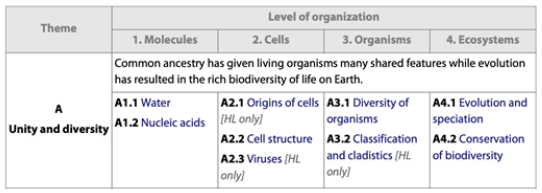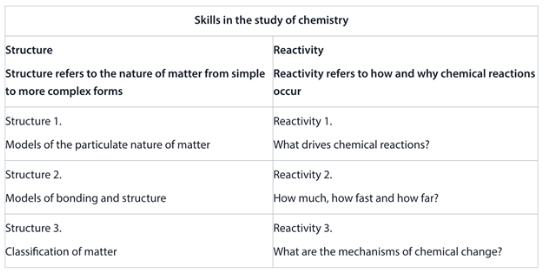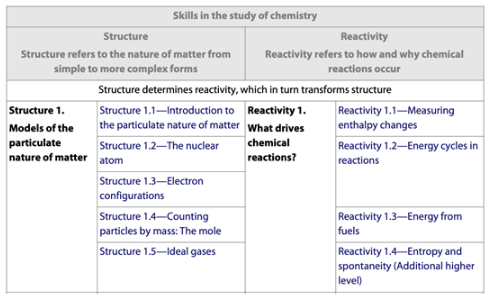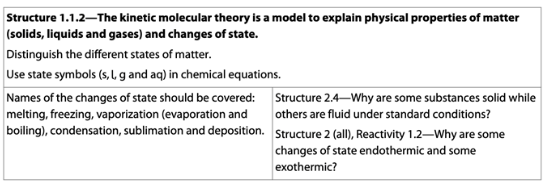The IB syllabus is an important resource for note-taking throughout the two-year journey and for revision during exam preparation. The syllabus outlines everything you need to know and hence everything that could be assessed in the end-of-year exams. It is a very valuable tool to help with organising your notes as it ensures you cover all the material and details required for a subject. In this blog, we will navigate the content of both the IB Biology and IB Chemistry syllabi and how they can help with effective note-taking.
Breakdown of IB Biology and IB Chemistry Syllabus
The IB syllabus is a structured document that outlines all the understandings and skills required for the assessments within each subject. It outlines the key learning objectives, with the use of command terms and inquiry questions, which provide guidance for the depth of understanding required. The syllabus for Biology and Chemistry is made up of core topics divided into numerous subtopics, which contain a series of statements known as ‘understandings’. These understandings are accompanied by other guidance statements and questions which describe all the examinable content. We will focus on the structure and organisation of the Biology and Chemistry syllabus and then look at its importance for effective note-taking.
IB Biology Structure
The biology syllabus is built on four broad organising themes, each comprising two concepts, together with four levels of organisation:
- Theme A: Unity and diversity
- Theme B: Form and function
- Theme C: Interaction and interdependence
- Theme D: Continuity and change
Each of the themes above is arranged into four levels of biological organisation, which serve as conceptual lenses:
- Level 1: Molecules
- Level 2: Cells
- Level 3: Organisms
- Level 4: Ecosystems
There are a number of topics that fall under each level of organisation for each of the four themes. The table below shows the organisation for Theme A: Unity and diversity, where each level of organisation is comprised of SL and HL topics.
The 40 subtopics in the IB Biology syllabus are divided into numbered ‘understandings’, which are in turn divided into a content statement and further guidance. The content statement indicates the content to be taught, whereas the guidance statements provide clarification to the scope and requirements of the understanding and applications of skills within the content statement. Applications of skills include directed activities that connect the understanding with a specific skill. It directs an action such as drawing from observation or a micrograph, interpreting data, utilising statistics, or designing an experiment.
Below is an example of the structure of the first content statement and guidance from Theme A: Unity and Diversity, Level of Organisation 1: Molecules.
IB Chemistry Structure
The IB Chemistry syllabus is built on two broad organising concepts: structure and reactivity. These two concepts are subdivided into three topics and multiple subtopics, which are all connected through the idea that structure determines reactivity.
Each of the six topics in the IB Chemistry syllabus contains several subtopics that make up a total of 22 subtopics. The table below shows the subtopics that make up Structure 1 and Reactivity 1.
Each subtopic is then divided into numbered syllabus points known as ‘understandings’. These are accompanied by additional content statements that highlight the outcomes of learning and teaching. The box in the bottom left of the table clarifies the requirements and parameters of the skills and understandings students should acquire. Whereas the box on the right contains linking questions from this subtopic to another subtopic from either of the two concepts.
Below is the second understanding (text in bold) and content statements from the Structure 1.1 - Introduction to the particulate nature of matter subtopic.
Using the IB Syllabus for Effective Note-Taking
The IB syllabus content statements clearly outline the required knowledge and depth of understanding for each topic, making it an effective note-taking resource. These content statements are not only found in the syllabus document but are also listed at the start of each subtopic in the IB Oxford textbooks for both biology and chemistry. These textbooks use these statements to create subheadings that organise all the information and material within the subtopic. This facilitates well-structured notes with relevant detail that follow the syllabus and ensure all content is covered.
As part of my active revision during IB, I created a document (for both Biology and Chemistry) that included summary notes for each understanding in the syllabus. I used my notes from class, the textbook information, and other resources to make structured summaries that were organised according to the understanding for each topic. This process ensures there is no material missed and the level of detail is sufficient, which helped with my confidence and prevented potential surprises in the end-of-year exams.
Consistently referring to the syllabus while studying or revising promotes a strategic method of study. It allows you to track your progress, align notes with specific syllabus points, and identify any gaps in knowledge. The syllabus becomes a tool to develop connections between ideas and other subtopics, and develop the critical thinking skills required for success in both assessments and real-world biological inquiry.
I therefore strongly recommend familiarising yourself with the syllabus and incorporating the understandings into your note-taking or revision. It can be as simple as using it as a checklist during exam preparation to ensure you have covered all concepts to the required level of detail.
Conclusion
The IB syllabus is a very important document and should be used as a guide for effective note-taking. Both the IB Biology and Chemistry syllabi have extra guidance to outline the level of understanding and skills required to keep your notes focused, clear and concise. Familiarising yourself with the syllabus not only ensures comprehensive coverage of key concepts but also assists with efficient and focused exam preparation. This process requires minimal extra effort but will ultimately make the IB learning journey more successful, thus allowing you to feel confident for your final exams.
Need extra guidance? If you found these tips helpful, I’d personally love to support you as your tutor this year. You can view my profile on Learnmate and contact me to discuss tutoring options. Alternatively, Learnmate’s tutors can help you refine your oral presentation skills, boost your confidence, and prepare for your QCE assessments. You can connect with other IB Biology tutors on Learnmate here.









